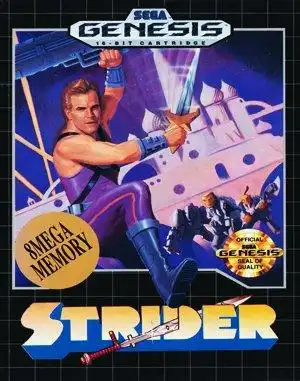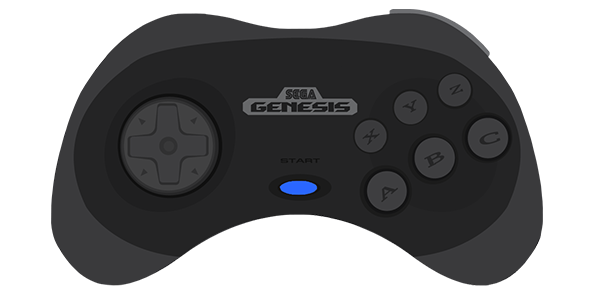Getting a new game for the Sega Genesis back in the day often meant bringing a piece of the arcade experience home. While some ports missed the mark, others captured the magic, becoming legendary in their own right. Capcom's Strider on the Sega Genesis is one such game, a lightning-fast, challenging action platformer that pushed the 16-bit console to its limits and earned a permanent place in the hearts of many retro gamers.
Released in 1990, just a year after its coin-op debut, the Strider Sega Genesis port arrived with significant hype. It was one of the early titles to utilize an 8-megabit cartridge, a massive size for the time, promising a home experience closer than ever to the arcade original. Did it deliver? For the most part, yes, bringing the acrobatic ninja Hiryu and his plasma sword into living rooms with surprising fidelity.
Bringing the Arcade Home: A Port Worthy of the Hype
The Genesis version of Strider was a technical marvel for its era. Capcom managed to squeeze the vast, multi-scrolling levels and large, detailed sprites of the arcade game onto Sega's hardware. While there were some expected compromises – a slightly less vibrant color palette, occasional sprite flicker, and missing voice samples – the core experience remained remarkably intact.
This wasn't just a scaled-down version; it felt like the real deal. The fluid animation, the sense of speed, and the sheer scale of the environments were impressive. It helped solidify the Genesis's reputation as the console for arcade conversions, a title it would hold proudly for years.
Hiryu's Acrobatic Moveset and the Demanding Challenge
Playing as Strider Hiryu feels fantastic. He's incredibly agile, able to run, jump, flip, and, most importantly, climb almost any surface. This unique wall-climbing mechanic is central to the game, allowing for vertical exploration and opening up tactical options against enemies. His primary weapon, the Cypher (a plasma sword), is fast and has a surprisingly wide reach, especially when powered up.
But make no mistake: Strider is tough. This is classic arcade difficulty, designed to eat quarters. Health is limited, power-ups are scarce (beyond the essential sword extension and temporary helpers), and environmental hazards are everywhere. Enemies come at you relentlessly, and bosses require pattern recognition and precise execution. It's a game that demands practice and pixel-perfect platforming. Those robotic helpers – the hawk, tiger, and mini-robot – are cool additions, but they drain your health to summon, adding another layer of risk/reward to the already high stakes.
Memorable Stages and Epic Boss Battles
Despite only having five main stages, Strider packs a punch with diverse and unforgettable environments. You'll swing through futuristic Soviet cityscapes, navigate treacherous prehistoric jungles filled with mechanical dinosaurs, and battle aboard a massive flying battleship with gravity-defying sections. Each level feels distinct and offers unique platforming challenges.
The boss fights are a definite highlight. From the iconic mechanical gorilla Mecha Pong to the gravity-core battle and the final confrontation with Grandmaster Meio, these encounters are creative and challenging. They often incorporate level mechanics, like the low gravity during the battleship boss, forcing you to adapt your strategy beyond just hacking and slashing.
Graphics, Sound, and... That Infamous Box Art
Visually, the Strider Sega Genesis port holds up well thanks to strong sprite design and varied backdrops. While some areas might look a bit muted compared to the arcade, the overall presentation is solid 16-bit goodness.
The sound is a bit more mixed. The music is decent, providing a fitting backdrop to the action, but it's not the most memorable soundtrack on the Genesis. However, the sound effects are crucial, particularly the satisfying 'CHING' of Hiryu's plasma sword connecting with an enemy. It's an iconic sound that perfectly captures the feel of the game's combat.
And then there's the box art. While the Japanese cover is sleek and dynamic, the Western box art... is not. Often cited as one of the worst covers of the era, it features a static, awkwardly posed Hiryu against a generic background that completely fails to capture the kinetic energy and unique style of the game. It's a hilarious contrast to the quality of the game inside and a common point of discussion among fans.
Is Strider on Genesis Still Worth Playing Today?
Absolutely. If you're a fan of challenging 2D action platformers, Strider on the Genesis is a must-play. Its tight controls, unique movement, and relentless pace still feel great. It's a game that rewards skill and perseverance, offering immense satisfaction when you finally overcome a tough section or boss.
Finding a physical copy can be a fun part of the retro collecting hobby, with carts still relatively accessible. For digital convenience, the Genesis version is often featured on compilations and services like the Nintendo Switch Online Expansion Pack (though you'll have to stomach that Western box art thumbnail!).
It might be short by modern standards, but like many great arcade games, its replayability comes from mastering its difficulty and enjoying the pure, unadulterated action.
FAQ
Q: Is the Sega Genesis version of Strider a good port of the arcade game? A: Yes, it's widely considered one of the best home ports of the era, faithfully capturing the core gameplay, levels, and bosses despite minor technical differences.
Q: How difficult is Strider on Genesis? A: It's quite difficult! It retains the challenging nature of its arcade counterpart with limited health, tough enemies, and demanding platforming sections.
Q: Is the game very long? A: No, it's relatively short, consisting of five main stages. However, its difficulty means it will likely take multiple attempts to complete, extending the playtime significantly.
Q: Can I play Strider on modern systems? A: Yes, the Sega Genesis version is available on services like the Nintendo Switch Online Expansion Pack and is often included in Sega Genesis/Mega Drive classic collections on various platforms.
Conclusion
Strider on the Sega Genesis remains a high-water mark for arcade-to-home conversions and a true classic of the 16-bit era. It's a game that demands your best, pushes your reflexes, and rewards you with some of the most satisfying 2D action you can find. Forget the dreadful box art; the pixelated adventure within is pure retro gold. If you've never played it, or haven't revisited it in years, it's time to grab your controller and become Strider Hiryu once more.


